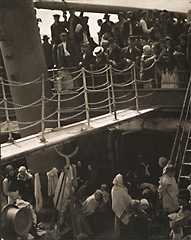Curriculum Materials: Art in America
|
|
Image 17 Alfred Stieglitz Questions: |
Look Questions Teacher Answer Key
1. Where are these people? (On a boat.) What clues led you to your answer. (Drawbridge, machinery, stairs from upper to lower deck, suggestion of mast in uppermost part.)
2. Describe the people in the upper part of the photograph. What are they wearing? What gender are most of them? Describe the people in the lower part. What are they wearing? What gender are most of them? Where do you see children? (One on top, others below.)
3. What is in each corner of this photograph? (Funnel, piece of mast, man, circular machinery.)
4. Upon seeing this scene, Stieglitz hurried to get his camera. He wanted to take the picture before the man in the round white hat, the man in the white crossed suspenders, and the seated woman with a child changed their positions. Find these people in the photograph. What does each figure contribute to the photograph?
5. What object in this photograph at once separates and joins the upper and lower portions of this image? (The drawbridge.) What kind of line does the drawbridge form? (Diagonal.) The railing between the decks? (Slight diagonal.) Where else do you see diagonal lines in this picture? (The stairs, the bridge support, the bridge railings, the large funnel pipe, the base of the mast, the crossed suspenders of the man on the bottom, etc.) How do the diagonal lines contribute to the mood of this photograph?
6. Where in this photograph do you see forms repeated? (The poles of the drawbridge, the curving chains of the bridge, the steps and the railings of the stairs, the bodies, heads, and hats of the crowd, the bars on the upper-level railing, etc.) Where do you see circles or cylinders? (Machine in lower left, funnel pipe, semicircle that supports bridge, hat on upper deck, bottom of boat mast.) What forms in this photograph create a large triangle? (The ship mast, the funnel leaning left, and the stairway leaning right.)
7. Was Stieglitz more concerned
with individual personalities or with the group as a whole?
(Group.) How can you tell? (Most of the people are
too far away to be seen as individuals; most of their faces
are out of focus, etc.) How does the emphasis on the
group rather than individuals contribute to the photograph's
COMPOSITION? (In
a crowd, the people become lines and forms like other
elements in the photo.)
|
|
